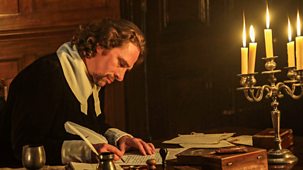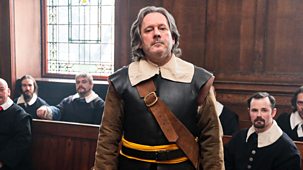
Series 1: Episode 3
On 23 January 1649, the third day of the king’s trial, Charles continues to publicly dispute the High Court’s legitimacy. There is no choice other than to move forward and enforce the charge against him. After two days of hearing witness testimonies concerning the king’s presence in battle, the evidence against him is overwhelming.\n\nOn 27 January, the king walks into the courtroom for the final time. He has come prepared to compromise, but it is too late for that now. John Bradshaw delivers an epic oration. He draws on constitutional history, including Magna Carta, and accuses the king of breaking his oath. Bradshaw states that the king was appointed by the people and it is the people who can remove him from power. ‘Farewell, sovereignty.' \n\nSentence is passed - Charles will be executed. Utterly beguiled, the king is removed from the courtroom, and over the next three days he prepares for death. Although the verdict has been delivered, Parliament’s cause is still fragile. Charles’s son, Prince Charles, is in The Hague mustering support for the crown. Invasion plans are already underway, and the clock is ticking, Parliament must get the king to the scaffold and put an end to the monarchy they believe has torn the country apart.\n\nDespite the king’s strength, determination and vigour in the courtroom, he begins to accept his fate and spends most of his time in prayer. He says an emotional goodbye to his two children who remain in England, Elizabeth and Henry. Their likeness from this time is captured in an exquisite portrait miniature. Princess Elizabeth never recovered from the trauma of parting with her father. She records an account of their last, devastating moments together.\n\nAs the king gathers his affairs and his state of mind, the death warrant is hurriedly drawn up and signatories - some say under duress from Cromwell - are gathered. Cromwell’s determination comes from his belief that he is enacting God’s will and delivering justice for the people who suffered at the hands of the feckless King. His mind is set. The execution must be carried out.\n\nOn a freezing morning on Saturday 30 January 1649, Charles I wakes up at 5am and puts on two thick shirts to offer him some protection from the blistering cold. Determined not to appear afraid, he must not shiver. As the king prepares for death, Parliament are appalled to discover there is no act that prevents succession. In haste they pass the act as a legal emergency.\n\nFinally, shortly before 2pm, the king is led through Banqueting House. He may have looked up at the Rubens ceiling that depicts his father ascending to the side of God as is his divine right. He makes his way through a window and onto the scaffold to deliver his final speech to the people, now inked into the pages of history. Lying down at the low block, he says ‘Wait for the sign’ before he stretches his arms aside and his head is struck off.\n\nPeople flock to the scaffold to dip their rags and kerchiefs in the blood of the king. Hair is cut from his severed head, to be preserved as relics, and the little pearl earring that delicately hung from his ear is carefully removed and remains preserved to this day.\n\nOn a freezing, bleak January day, King Charles I was killed and a republic was born. But did he die as a murderer or as a martyr?
Source: BBC 4
Most recent episodes of Charles I: Killing a King
Charles I: Killing A King
Series 1: Episode 3
On 23 January 1649, the third day of the king’s trial, Charles continues to publicly dispute the High Court’s legitimacy. There is no choice other than to move forwa ...
14-01-2025
BBC 4
Charles I: Killing A King
Series 1: Episode 2
January, 1649.\n\nOn Tuesday 9 January 1649, crowds gather in Cheapside, London as a proclamation is read out. King Charles I will be put on public trial at Westminster Hall in ...
13-01-2025
BBC 4
Charles I: Killing A King
Series 1: Episode 1
December, 1648.\n\nThe Puritan government has banned all celebrations and King Charles I is imprisoned in Windsor Castle. During Christmastide, the monarch would ordinarily feas ...
12-01-2025
BBC 4
Most popular episodes of Charles I: Killing a King
Charles I: Killing A King
Series 1: Episode 2
January, 1649.\n\nOn Tuesday 9 January 1649, crowds gather in Cheapside, London as a proclamation is read out. King Charles I will be put on public trial at Westminster Hall in ...
13-01-2025
BBC 4
Charles I: Killing A King
Series 1: Episode 1
December, 1648.\n\nThe Puritan government has banned all celebrations and King Charles I is imprisoned in Windsor Castle. During Christmastide, the monarch would ordinarily feas ...
12-01-2025
BBC 4
Charles I: Killing A King
Series 1: Episode 3
On 23 January 1649, the third day of the king’s trial, Charles continues to publicly dispute the High Court’s legitimacy. There is no choice other than to move forwa ...
14-01-2025
BBC 4



